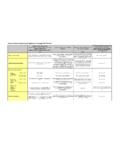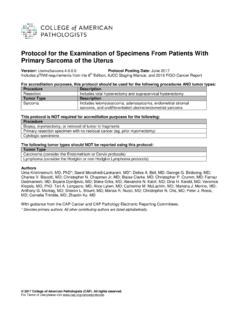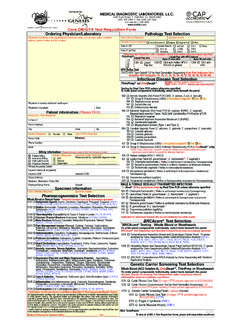Transcription of Chapter 10: Pap Test Results - Lakeridge Health
1 PAP TEST LEARNING MODULE FOR Health CARE PROVIDERS | Chapter 10 | PAGE 1 Chapter 10: Pap Test Results Learning Objectives On completion of this section, the learner will be able to: 1. Identify how Pap test Results are interpreted and the reasons for normal and abnormal Results . 2. Describe the appropriate follow-up for each Pap result using the CCO Screening Guidelines. The Bethesda System1 The terminology for reporting cervical cytology is based on The Bethesda System which is the internationally recognized reporting standard. Specimen Adequacy The two categories of specimen adequacy are: Unsatisfactory for Evaluation Satisfactory for Evaluation Unsatisfactory for Evaluation Unsatisfactory for Evaluation indicates that: The specimen was processed and examined but was unsatisfactory for evaluation because of obscuring factors (excessive RBCs, WBCs or mucous) or insufficient epithelial cells or cytolysis.
2 The reason the Pap test was considered Unsatisfactory for Evaluation will be indicated in the report. Unsatisfactory Pap tests are mostly due to: cervical sampling errors, or specimen collection issues (refer to Chapter 9 to review Pap test sampling techniques). PAP TEST LEARNING MODULE FOR Health CARE PROVIDERS | Chapter 10 | PAGE 2 The following table identifies and describes each reason for Unsatisfactory Pap test Results : Unsatisfactory due to: Description Mainly endocervical cells only Only cells from the endocervix are visible. Acellularity Not enough cells were collected to interpret the sample. Insufficient epithelial cells Not enough cells were collected to interpret the sample. Obscuring inflammation There is a presence of infection and/or necrosis (dying cells, usually due to disease) in the sample.
3 Obscuring blood The presence of blood in the sample makes it inadequate for interpretation. Lubricant or other foreign material Other foreign material, lubricant exists on the sample making it difficult to interpret. Factors associated with the client may also produce Unsatisfactory Pap tests Results . These include: Intercourse within 24 hours of Pap test Douching or vaginal medication used 24 hours before Pap test Menses Infection Satisfactory for Evaluation The diagnostic categories are: Negative for Intraepithelial Lesion or Malignancy Epithelial Cell Abnormality Other Negative for Intraepithelial Lesion or Malignancy Where there is no cellular evidence of neoplasia, Pap tests are interpreted as Negative for Intraepithelial Lesion or Malignancy. Clients with negative Results can typically continue with routine screening.
4 Epithelial Cell Abnormality Pap tests interpreted as Epithelial Cell Abnormality include both those that: Represent cervical carcinoma, and PAP TEST LEARNING MODULE FOR Health CARE PROVIDERS | Chapter 10 | PAGE 3 Have changes considered to indicate increased risk of cervical carcinoma. Changes indicative of increased risk for cervical carcinoma are reported as: Squamous Cell Atypical squamous cells (ASC) o of undetermined significance (ASC-US) o cannot exclude HSIL (ASC-H) Low-Grade Squamous Intraepithelial Lesion (LSIL) High-Grade Squamous Intraepithelial Lesion (HSIL) Squamous cell carcinoma Glandular Cell Atypical o glandular cells (AGC) o endocervical cells o endometrial cells Endocervical adenocarcinoma in Situ (AIS) Adenocarcinoma o Endocervical o Endometrial o Extrauterine PAP TEST LEARNING MODULE FOR Health CARE PROVIDERS | Chapter 10 | PAGE 4 Management of Abnormal Cytology Results The following table shows CCO s recommendations for follow-up of abnormal Pap test Results .
5 Other Results Absence of Transformation Zone Cells Important Information The decision to repeat a Pap test should be based on the cytology diagnosis and not the presence or absence of transformation zone cells. Screen according to the cytology result. Sufficient sampling of the transformation zone (TZ) include an adequate number of squamous and endocervical cells (EC) or metaplastic cells or dysplastic cells. Lack of TZ/EC on a Pap test is often seen in postmenopausal and pregnant clients. In the absence of these clinical scenarios, the lack of TZ/EC may indicate improper screening technique. Studies show that dysplastic/SIL cells are more likely to be present on Pap tests where TZ/EC are However, retrospective cohort studies have shown that women with Pap tests lacking TZ/EC are not more likely to have squamous lesions on follow-up than are women with EC.
6 3 4 Finally, retrospective case- control studies have failed to show an association between false negative interpretations of Pap tests and lack of 6 Cross-sectional studies PAP TEST LEARNING MODULE FOR Health CARE PROVIDERS | Chapter 10 | PAGE 5 have consistently demonstrated a higher percentage of cytological abnormalities in conventional Pap tests with evidence of TZ sampling than those 7 8 9 Longitudinal studies have not shown an increased risk of high-grade lesions or cancer in women with Pap tests lacking TZ 10 11 Clients with Pap test Results that are Negative for Intraepitheleal Lesion or Malignancy , and report an absence of transformation zone cells, do not need a repeat Pap test - the client may remain in routine screening unless: They have had a previous Pap test result that is High-Grade and does not have three subsequent negative Pap tests , with at least one that has TZ/EC, They have ever had a previous Pap test result that is AGC, They have had a positive HPV test within 12 months, The HCP cannot see the entire cervix upon visual inspection, They are immunocompromised, and/or They have an insufficient screening history (lack of routine screening every 3 years).
7 A Pap test that lacks TZ/EC in clients who have persistent postcoital bleeding (PCB) or intermenstrual bleeding (IMB) should be referred to colposcopy or gynecology. Rejected Specimen A specimen may be rejected for one of the following reasons: The specimen is improperly labeled The specimen is not labeled with sufficient personal identification Discrepancy of information between the specimen and the requisition The specimen is received without accompanying requisition Limitations of Pap Test Results A false negative result occurs when the Pap test fails to detect an abnormality that is present on the cervix. False negatives occur because either: Abnormal cells are not present due to limitations of cervical sampling and Pap test preparation, or The laboratory did not identify abnormal cells in the Pap test.
8 Important Repeat screening at regular intervals is necessary to provide adequate lifetime PAP TEST LEARNING MODULE FOR Health CARE PROVIDERS | Chapter 10 | PAGE 6 Information protection from cervical cancer. Most sexually active clients should be screened every three years. Talking to Clients about Abnormal Pap Test Results The psychological impact of having an abnormal result varies between clients. How a HCP communicates an abnormal result can impact the client s perspective and subsequent psychological response. Below are some suggestions for how to communicate abnormal Pap test Results : Inform the client that their Pap test result is abnormal, meaning that the Pap test has detected abnormal cell changes on the cervix. Abnormal cell changes are caused by the HPV virus.
9 In rare circumstances, and often over a long period of time, abnormal changes caused by HPV can become cancerous. Reassure the client that their abnormal result is most likely not cancer. Normalize HPV. Reassure the client that HPV is very common. Three out of four people will have at least one HPV infection in their lifetime. Most infections will disappear on their own. Use Cervical Cancer Screening What your abnormal Pap test means pamphlet, available at: ) to help explain the meaning of the result and the recommended follow-up. Ensure the client understands the information you have provided her and clarify any misunderstanding. Remind the client that most clients who have abnormal Pap test Results and who have follow-up tests and/or treatment will never get cancer of the cervix.
10 Address any fears/barriers that may prevent them from following up on the recommended course of action. Clients can contact Cancer Care Ontario for more information. See Appendix 1: Resources and Education for public-facing resources. Colposcopy 12 13 Colposcopy is a diagnostic procedure performed after an abnormal Pap test result. This procedure allows a Colposcopist to take biopsies of cervical abnormalities so a pathologist can make a definitive diagnosis and a doctor can help to develop a treatment plan if needed. The cervix is magnified through a binocular scope with a high intensity light. This allows for the identification of abnormalities based upon: Epithelial density (white epithelium) PAP TEST LEARNING MODULE FOR Health CARE PROVIDERS | Chapter 10 | PAGE 7 Vascular patterns (punctation, etc.)







